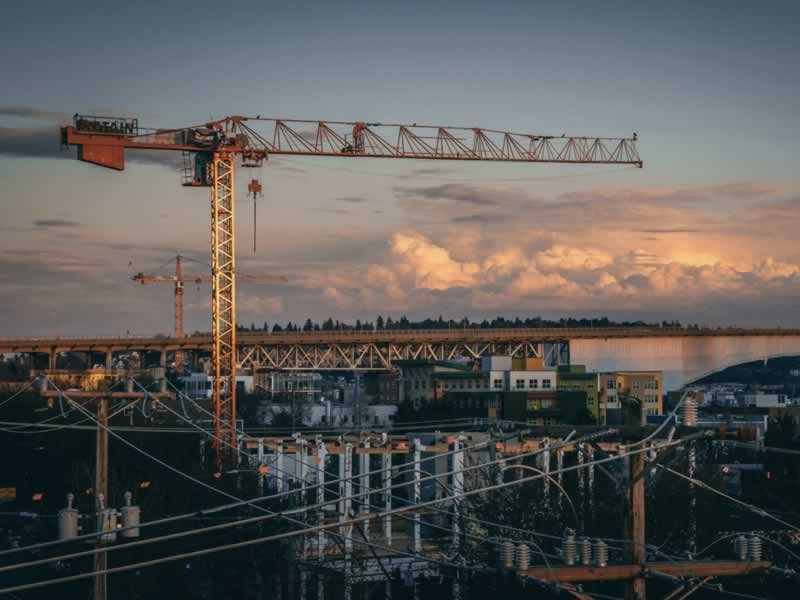Insight Blog
Agility’s perspectives on transforming the employee's experience throughout remote transformation using connected enterprise tools.
14 minutes reading time
(2893 words)
The Growing Role of AI in Organizational Infrastructure in 2024
Analyze how AI transforms the organizational structure and interacts with the culture of the modern business environment.
The organizational structure is now being interlaced with AI, which, in turn, is altering the way that businesses are run and innovation takes place. AI is also the force that drives the adjustment of systems from the status of a place where efficiency reigns to the place where new strategic possibilities arise.
Did you know the global construction market is forecasted to reach an astounding $15 trillion by 2025, with a Compound Annual Growth Rate (CAGR) of 7%? Despite its vast size, this market is highly fragmented, featuring a complex supply chain and numerous stakeholders involved in infrastructure development. With many components to synchronize, effective management has long been crucial for success in this sector—until now.
We are introducing artificial intelligence (AI) to revolutionize future planning and the management of every development phase, from initial planning to execution and beyond. AI carries the potential to transform the landscape of infrastructure development completely. From predicting demand for new construction projects to optimizing material design and supervising building construction, AI is overhauling every aspect of infrastructure development.
In this article, we'll explore how AI reshapes infrastructure development. We'll examine the obstacles of traditional management methods and then explore how AI is streamlining and enhancing the development process management like never before.
This article will provide a definition of organizational infrastructure, its entire role in operations, and some practical examples of it.
We will look into the role played by AI in these components, namely, the infrastructure and culture of the organization, and we will learn how both of them are essential to successful business performance.
What Is Organizational Infrastructure?
Organizational Infrastructure and Its Components
Organizational infrastructure represents the key and basic systems and frameworks that are the core of any business operation.
Organizational infrastructure in the business world refers to the framework that defines the hierarchy within a company. It identifies each employee's role, responsibilities, and who they report to within the organization. It's how a company is structured, including the relationships between directors, managers, and employees.
Organizational infrastructure is how people within the company, from employees to CEOs, interact. It also encompasses any external entities like agencies, schools, or charities with which the business is involved. According to Market Business News, organizational infrastructure outlines tasks assigned, supervised, and coordinated to achieve the company's goals.
This infrastructure helps employees understand the company's hierarchy and work environment. Since organizational infrastructure is based on hierarchy, there needs to be some structure, such as a chain of command or centralized decision-making, to define how decisions are made within the organization.
This infrastructure consists of a number of components, which include buildings and equipment, technology systems that are intended to manage data and communication, and policies for the administration of the labor force. Speaking of how it is comprised, it is the body of the enterprise that performs each business unit's daily functions, including supply chain management, customer relationship management, and information technology services.
These components, in total, create an organizational system, and this serves as the ultimate factor that allows the organization to function effectively and immediately respond to market cues or within the system.
Importance of a Well-Planned Infrastructure
The optimal organizational structure that will be the cornerstone of operational efficiency and assist in meeting targets is a well-designed organizational structure. The platforms create a basis that is stable and trustworthy for all the business operations that take place in it. It is one of the key factors that allow unceasing quality service provision and customer appeasement.
The proper infrastructure also empowers the scalability that makes the business grow without any hurdles or being limited in terms of performance. The strategic planning for infrastructure is also a move to make organizations resilient to all unforeseen challenges like economic fluctuations, technological changes, or even natural disasters.
A well-planned infrastructure plays a crucial role in developing and functioning societies, economies, and environments.
Here are several key reasons why:
- Economic Growth: Infrastructure such as roads, bridges, ports, and airports facilitate the movement of goods and people, enabling businesses to operate efficiently and access new markets. This fosters economic growth and stimulates investment.
- Job Creation: Infrastructure projects require significant labor, from construction workers to engineers and project managers. Investment in infrastructure creates employment opportunities, reducing unemployment rates and stimulating local economies.
- Improved Connectivity: Modern infrastructure enhances connectivity between regions, countries, and continents. Highways, railways, and internet networks enable smoother communication, trade, and collaboration, fostering innovation and cultural exchange.
- Enhanced Quality of Life: Infrastructure directly impacts people's daily lives. Access to clean water, sanitation, electricity, and reliable transportation improves public health, education, and well-being, particularly in underserved communities.
- Resilience and Sustainability: Well-planned infrastructure considers environmental sustainability and resilience to natural disasters. Green infrastructure, such as renewable energy sources and efficient public transportation systems, reduces carbon emissions and mitigates climate change impacts.
- Attracting Investment: Countries with robust infrastructure are more attractive to foreign investors. Reliable transportation networks, modern utilities, and efficient logistics reduce business costs and risks, encouraging domestic and foreign investment.
- National Security: Infrastructure is critical for national security and defense. Secure communication networks, transportation systems, and energy supplies are essential for safeguarding a country's interests and responding to emergencies.
- Social Equity: Equitable distribution of infrastructure resources is vital for reducing disparities and ensuring social justice. Accessible transportation, affordable housing, and healthcare facilities help bridge the gap between different socio-economic groups.
- Long-term Planning and Development: Infrastructure projects often have long lifespans and impact future generations. Strategic planning and investment in infrastructure lay the foundation for sustainable development and economic prosperity over the long term.
- Global Competitiveness: Nations with advanced infrastructure are more competitive globally. Efficient transportation hubs, modern communication networks, and reliable utilities enhance productivity, innovation, and trade, positioning countries for success in the global economy.
Having an adequate organizational structure is one of the key components that can help any company to achieve its long-term goals and to remain competitive in the market.
Organizational Infrastructure & Operations - A Complete Guide
Supporting Operations Through Infrastructure
The organizational infrastructure and operations are inseparable. This is because each component of the infrastructure plays a fundamental part in increasing the efficiency and effectiveness of business operations. The usefulness of organizational infrastructure in the maintenance of operations is in the form of the design, construction, and running of the company's buildings, while the IT systems that manage the business data cannot be left behind.
For instance, the distribution centers situated strategically serve the purpose of logistics and supply chain operations by reducing delivery time and cost. In addition, having an office in which workspaces are intended for collaboration has been shown to increase employee productivity and foster a culture of teamwork.
In addition to the production process, process infrastructure is key for operational efficiency.
This involves the operational processes, the processes for fulfilling the daily business operations, and the policies that regulate these operations.
The processing infrastructure is an essential factor that helps in executing the operations in a uniform manner and with precision, thereby reducing errors and improving performance. It also covers crisis management and contingency planning, which readies the organization for the operations to carry on smoothly even under such conditions, and hence, business continuity.
Integrating Technology in Infrastructure
Technological integration in a company's infrastructure is not optional but a must-have in the modern digital environment. Modern infrastructure is built on information technology systems that allow for the automation of complex processes and for smooth communication both inside and outside of the organization.
Apart from this, the ERP systems (Enterprise Resource Planning) integrate the core business process in real-time, which aids decision-making and operational efficiency. Similarly, CRM systems can be implemented to improve contact with clients so that the clients will be satisfied with the business and will become loyal to it.
Outside these systems, technology, including data management and analytics, is emerging as a key factor in operation strategies. Data infrastructure is a useful tool for operations since it gives managers the information not only for them to take action but also to assist them with their planning for the future.
For instance, predictive analytics can help to say what will happen with trends in the market, allowing companies to adapt their production to meet future requirements. AI and machine learning can also be utilized in infrastructure systems supply chains to predict maintenance needs and to personalize customer interactions, all making operational efficiency even better.
Follow us and access great exclusive content everyday: Follow us on Google News
Organizational Infrastructure Examples
Organizational infrastructure examples from different industries show how strong systems and structures can help to drive success and competitiveness. The ones below are the two that have the best times that companies have used their infrastructure for operational excellence and strategic advantage.
Amazon's Distribution and Data Systems
Amazon's worldwide success is mostly due to its pioneering distribution network and advanced data management systems.
The organization uses many decentralized fulfillment centers equipped with cutting-edge robotics technology and sophisticated inventory management systems, which are located throughout the world. Such physical and technological infrastructure helps Amazon provide customers with amazing speed and efficiency, allowing them to get their orders shipped out with same-day or next-day delivery options.
Besides that, Amazon's big data analytics to predict customer purchasing behavior has contributed to better inventory management, which has led to reductions in waste and ensures stock availability.
The advantages of these infrastructural improvements are not only in the operations but also in increased customer satisfaction and loyalty.
You may also like: Best Apps for Employees: UPDATED 2022 – A Complete Guide
Google's Computing Infrastructure
Google's business success can be considered another example of organizational infrastructure based on the latest technologies, which brings the idea of the importance of technological infrastructure to the point. Being one of the largest and most sophisticated networks across the globe, Google's big data center is very famous and popular for its immense computational facilities.
Data centers are the core of their business and can also be used for other projects like search, cloud services, or consumer applications such as Google Drive and Gmail. A Google query system is developed to process a huge number of orders every second. It can manage an enormous amount of data with minimum relaxation.
This digital technology platform has been the main factor that makes it possible for Google to lead the digital space, keep innovating, and continuously grow.
The Growing Role of AI in Organizational Infrastructure
Free ebook: How To Get Your Intranet Off The Ground
Enhancing Decision-Making Processes
The organizational structure AI is one of the fastest developing areas that has brought a new perspective to businesses in terms of operations, decision-making, and data management. One of the greatest impacts of AI in the decision context occurs during the implementation of AI technology in the organizational infrastructure.
The key element of AI is machine learning algorithms, which process data from multiple sources, recognize patterns, and, finally, foresee the results.
The inclusiveness of AI means companies can now make more precise and rapid forecasts. To do so, consider that, thanks to AI-powered analytics systems, it is possible to predict market demands, determine price options, or make changes in the product line. Through this process, the task not only speeds up the decision-making process but also corrects the accuracy of the results, which, in return, leads to better strategic outcomes and strengthened competitive positioning.
Boosting Operational Efficiency
AI contributes to the improvement of operational efficiency and performance in a very important manner.
AI technologies automate unchanging jobs and eliminate the possibility of human errors. Therefore, the processes can be completed much faster. AI has the capability of making a logistics and supply chain network that is most optimized by automatically predicting the best routes and inventory level management. Furthermore, such machines can perform these kinds of tasks at minimum cost and faster than a human worker can.
Robotics, however, goes beyond just saving time. It is about cost-cutting, which requires no second thought on its efficiency and lean business model.
Revolutionizing Data Management
Lastly, AI plays a large part in the data management process of an organization, along with its infrastructure.
Human resources could be replaced by AI programs that are capable of working with data more rapidly and precisely than with traditional methods. Their ability to handle data efficiently, identify deviations, and make vital contributions to operations and decisions is very important.
Besides AI, real-time data processing can also help AI perform in real-time, which is necessary for dynamic and highly responsive businesses. To give an example, AI can be used in customer relationship management systems that enable real-time data access, thus improving customer service and engagement to a higher level.
Organizational Infrastructure Vs Culture - How Do They Differ?
Infrastructure vs culture in corporate culture—these two fundamental elements of the organization play and have an impact beyond the confines of the company. The organizational structure consists of the physical and technological facilities that enable operations at the firm level, such as buildings, IT networks, and operational processes.
Tangible infrastructure is the very channel through which all business-related activities pass. At the same time, the organizational culture is the unseen ethical, philosophical, and behavioral identity of a company that influences employee interactions and decision-making through shared values, beliefs, and behaviors.
The culture of a workplace is a unique factor that influences how workers interact with their tasks while also shaping the environment in which they work.
Interplay between Infrastructure and Culture
The infrastructure and culture of an organization show a strong connection in the way they are made. Infrastructure can play a role in dominating culture by making the workplace environment and providing the tools that help employees do their work in a more effective way. For example, the open-plan office layout can foster transparency and collaboration, which form the basis of company culture.
However, an organization with a strong culture of innovation may apply AI and cloud computing technologies for more advanced infrastructure solutions, the process of which ensures that the limited resources of the organization are used according to the cultural aspirations of the organization.
The Role of AI in Shaping Both
AI is an integral part of both the physical and the cultural fabric of an organization, and it has a catalytic effect where the structural and the thorough aspects of the organization are intertwined. As for infrastructure, artificial intelligence increases efficiency by automating and handling data through sophisticated analytics.
As for culture, AI is a new factor that creates a different dynamic by capitalizing on data and creativity, which encourages a shift toward data-driven decision-making and innovation. Operational efficiency is also enhanced as employees get accustomed to integrating and adjusting to the new technologies in their workflows.
Several key factors are propelling the growth of the construction industry:
- Increased demand for new construction projects: With the global population expanding rapidly, there's a heightened need for new construction endeavors. Artificial Intelligence (AI) plays a crucial role in predicting and meeting this demand by forecasting future needs and trends.
- The imperative for enhanced efficiency and safety: The construction process often grapples with sluggishness, high costs, and safety risks. AI intervenes here, automating tasks like material design and construction to enhance efficiency and safety measures.
- The necessity for innovation: To retain a competitive edge in the global market, construction firms must prioritize innovation and efficiency enhancements. AI emerges as a pivotal tool for infrastructure developers to achieve precisely that.
- The surge in demand for heavy data processing: Infrastructure projects churn out massive amounts of data, such as location-based services, necessitating robust computing power and capabilities for effective processing. AI steps in to accomplish this, tackling complex tasks swiftly and efficiently.
The modern intranet platform with 90% employee adoption – Build a Culture with AgilityPortal
Boost employee engagement and drive adoption of our intranet platform from AgilityPortal. Say goodbye to disconnected and disengaged frontline workers as company leaders effortlessly captivate their teams. It's time to bid farewell to outdated corporate intranet solutions that employees barely utilize. Ready to try?
Wrapping up
We have discussed the key elements of organizational infrastructure and its vital function in operations, and we have given examples of how solid infrastructure helps businesses achieve success. We have also outlined the delicate relationship between organizational culture and infrastructure by discussing the fact that they are different yet have a synergetic impact on a company's success.
The incorporation of AI has bolstered the growth of the business intelligence sphere over the years by improving decision-making, process efficiency, and data management.
Moving forward, the transformation of AI is anticipated to continue to restructure both organizational structure and culture while contributing new ways of revamping existing processes and inventing new paradigms for how businesses operate and develop.
Categories
Blog
(2640)
Business Management
(325)
Employee Engagement
(212)
Digital Transformation
(177)
Growth
(120)
Intranets
(119)
Remote Work
(61)
Sales
(48)
Collaboration
(37)
Culture
(29)
Project management
(29)
Customer Experience
(26)
Knowledge Management
(21)
Leadership
(20)
Comparisons
(6)
News
(1)
Ready to learn more? 👍
One platform to optimize, manage and track all of your teams. Your new digital workplace is a click away. 🚀
Free for 14 days, no credit card required.

















